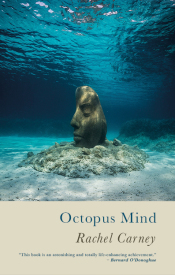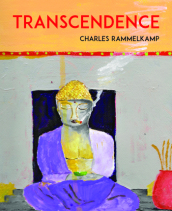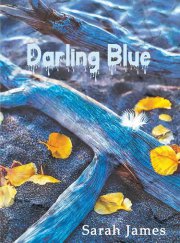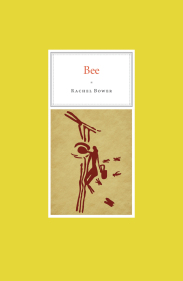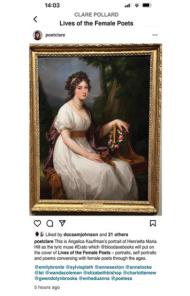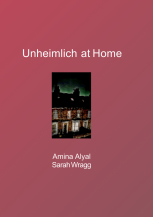
Rachel Carney, Octopus Mind, Seren Books, 2023. ISBN 9 781781 727102. 64pp. £9.99
At the heart of Carney’s debut collection is the poet’s determination to recruit or order language, portrayed as an often slippery medium, to expresses a sense of a diversity of selves. Owning her neurodiversity as both a stumbling block and a launchpad to creativity and compassion, Carney crafts poems which tell stories, create possibilities, and embrace challenge.
At times, ekphrastic prompts are evident – unsurprising, as her current PhD studies explore the use of ekphrastic poetry as a tool for visitor engagement in art museums and galleries. Gwen John and Elizabeth Siddal stand out as significant precursors in the journey towards self-expression:
A woman paints because she can, because the universe allows her to …
A woman paints a newer version of herself. This one is polished, yellow,
flat, serene. (“Unremarkable”)
“You See Yourself” won the Pre-Raphaelite Society Poetry Competition in 2021, and it was nominated for the Forward Prize. Its taut patterning of rhyme resembles the form of a sestina, but takes us beyond that into startling originality.
The title poem picks up on a recurrent concern – the gaps, alienation, rejection experienced by the neuro-diverse individual endeavouring to understand and be understood by a world which seems determined to ‘other’ diversity. In this poem,
‘ … each word / is worn down to the bone’, and the incessant clawing for meaning is vividly captured by ‘my octopus mind’ which
reaches out its tentacles
to grasp the core of each word you spoke,
turning them over and over,
tapping them to see what might fall out.
In “Two Seconds of Silence” the frustrations and experience of exclusion from conversation – caused by processing delays – likewise marshals a dizzyingly collection of words to describe the irony of being unheard and ignored while
… my mind
is doing backflips cartwheels death-defying twists to get your
words into order.
In lighter mood, “Nine Brains at Midnight” effectively conveys the over-stimulation experienced at the end of the day, and how hard it is to unwind and switch off:
The seventh brain is composing a poem about a person who lies awake
at midnight, composing a poem …
And the ninth brain is wishing that the other eight brains would just
Shut Up and let it dream
There is grief that ‘ … a mind would do this / to itself’ (“I half-close my eyes”) and, at times, fear: the capitalized ‘FOX!’ who leaps onto the page in the middle of “Self-Portrait with Words and Feathers” places the reader alongside the cooped-up hen/poet, temporarily in
a safe cage, a netted haven
of preening and cooing, as each thought grooms itself.
Yet underlying the distress is a determination to persevere, a sense that at the end
… when the spell breaks –
it surfaces:
wave after wave of clear, uninhibited release.
Hannah Stone
To order this book click here
Hannah Stone is the author of Lodestone (Stairwell Books, 2016), Missing Miles (Indigo Dream Publishing, 2017), Swn y Morloi (Maytree Press, 2019) and several collaborations, including Fit to Bust with Pamela Scobie (Runcible Spoon, 2020). She convenes the poets/composers forum for Leeds Lieder, curates Nowt but Verse for Leeds Library, is poet-theologian in Virtual Residence for Leeds Church Institute and editor of the literary journal Dream Catcher. Contact her on hannahstone14@hotmail.com for readings, workshops or book purchases.
Charles Rammelkamp, Transcendence,
lazeVOX Books, 2023. ISBN 9781609644277. 116pp. $18.
Transcendence, Charles Rammelkamp's latest poetry book, is a wild ride into seventy years of consciousness altering experiments by celebrities, famous and infamous, as well as ordinary people, who sing, complain, report, and reminisce about psychedelic drugs, yoga and meditation. Rammelkamp specializes in persona poems that bring to light many sides of a historical subject. In his twelfth book, he presents a kaleidoscopic view of transcendence with wit and humanity. A reader can easily travel along with the collection's rich, sometimes surprising content, or stop and savor the subtle rhythms and rhymes and economical language in Rammelkamp's conversational style.
The book is divided into five sections. The first, "Kiss the Sky," introduces the reader to a droll, first-person narrator who may or may not be the author himself. In the first poem, he looks back on an LSD trip he took with a friend as a college student in the early seventies, in the friend's "student pad,” surrounded by Grateful Dead posters and strobe lights.
Greg had lazy eye syndrome — amblyopia —
his right eye wandering around in its socket
like a ricocheting pinball.
As I watched, the eye crawled down his face,
sprouted eight spider legs,
ran down his pants
and scurried under the couch.
Rammelkamp deftly intersperses poetry about the narrator's experiences with poems that animate American popular culture’s responses to LSD and other drugs used for recreational purposes, highlighting quotes from Art Linkletter, the Beatles, Timothy Leary, Merle Haggard, Mike Tyson, and others.
In the book's second section, "Glen Webber Investigates," the narrator has shifted to an imaginary reporter scrutinizing the CIA's mind-control programs, projects that employed LSD, heroin and mescaline. This reader was fascinated by the intricately connected system of abuse that Webber uncovers.
The CIA directed experiments on prisoners and soldiers. One of those prisoners' stories is the crux of the poem "Sean McClanahan, Ex-Con, Remembers Whitey Bulger."
Once he described the flesh of another inmate's face
melting and falling away, revealing his skull,
saw the flesh melt in his hands,
turning into the little white sticks of finger bones,
saw blood spewing out of the overhead lightbulbs.
Sean McClanahan wonders if Whitey Bulger's vivid LSD trips led him to become a "cold-blooded murderer," "killed by inmates within hours of his arrival / at the U.S. Penitentiary in Virgina."
Several poems in the section involve the reporter delving into the life and death by apparent suicide of Frank Olson, a biological warfare scientist who worked in Special Ops for the U.S. Army. "Preparations" describes Webber's early research.
I already knew Olson had witnessed
"expendables" — suspected spies, moles, security leaks —
tortured, drugged and hypnotized —
to master brainwashing techniques, memory erasure —
at various CIA "safe houses" in postwar Germany.
What the reporter discovers becomes the most haunting part of Transcendence.
Rammelkamp does intersperse this section with interview poems focused on less tragic characters, including Bill Wilson, the founder of Alcoholics Anonymous, who tried LSD then claimed, in the poem "Are You Experienced?", that the drug helped
eliminate the barriers
erected by the ego
that block direct experience
of the cosmos and God,
a way to find that
"power greater than ourselves."
The main attraction of "Tune In, Turn On," the third section of Transcendence, is Timothy Leary: his work; exploits; colleagues, lovers and kids — and his death.
Leary even had a relationship with G Gordon Liddy, the FBI agent sent to prison for his role in the Watergate scandal. "Timothy Leary and Gordon Liddy in the Afterlife" describes their relationship, beginning in 1966, when Liddy was a Duchess County prosecutor investigating Leary's questionable experiments at his research center, a place where, Liddy claimed: "the panties were dropping as fast as acid."
Fifteen years later, both men ex-cons by then —
Leary'd had a cell in Folsom Prison
right next to the cult murderer Charles Manson —
the two teamed up on the lecture circuit,
caricatures in a culture debate,
cashing in on their lurid pasts
at the expense of the last shards of their integrity.
Rammelkamp returns to the first-person persona of the book's opening poems in the next section, "Mindfulness." The narrator is taking a yoga class with his wife, where he engages and disengages from meditative practices in an effort to reach a little peace of mind about his position at the threshold of old-age. "I sneak a peek / at her sweet kundalini," he confesses as he watches the woman next to him during a cat-cow sequence in the poem "Squeeze Up," but his mind follows his teacher's instructions in "Let's Turn Back the Clock, Starting Now."
I picture Ponce de Leon
dipping his toe into the Fountain of Youth,
he wrinkles on his face evaporating like dew,
scars disappearing
as if erased with an airbrush,
the hair on his head turning darker,
thick as coiled snakes.
"The Psychonaut," the collection's last section, is firmly rooted in the United States of 2023. Michael Pollan's book, How to Change Your Mind, about the re-emergence of psychedelic substances as a legitimate part of therapeutic treatment, has been popular for half a decade. Michael Pollan is one of the many inspirations behind the section's poems about current experiments with psychedelics to deal with sexual intimacy, addiction, depression and death. Another is the couple in "Modern Day Researchers," who recorded their "sex on acid" experience "for an on-line tripping journal / called On the Road Again." They describe sex acts accompanied by "closed-eye visuals / colorful, rapid, stuttering," that were "so intense / like I was on a cloud or something." In this poem, and throughout Transcendence, Rammelkamp travels a fine line between satire, social commentary and respect for our human need to reach beyond ourselves, a road full of consequences, fun, or even "a whole new approach to life" not focused on a destination but "a more timeless, formless now."
Alison Morse
To order this book click here
Alison Morse's poetry chapbook, The Price of Our Clothes, was published by the Perlman Museum. Her poems have appeared in Puerto del Sol, Portland Review, and Rhino, among other journals and anthologies. She also wrote the flash-fiction collection, If You Wave a Chicken Over Your Head (Red Bird Chapbooks).
Frances Sackett , House with the Mansard Roof, Valley Press, 2022. ISBN: 978-1-912436-80-4. 79pp. £10.99.
Frances Sackett’s third collection picks up on the themes and tropes of her previous book, Cradle of Bones, but is even more assured in the realisation.
The most obvious strand of her endeavours is her continuing interest with writing ekphrastic poems. The artists she pays homage to include Magritte, Bonnard, Van Gogh, and Monet. What is commendable is how all the poems inspired in this way are fully realised works that are not dependent on the source material. ‘Giverny’, for instance, referencing Monet’s house in Normandy, is vibrant with sensuous but delicately executed detail that builds to a resolution that is not only visually satisfying but aurally too: “you feel / in this infinite world of water / where willows dip into shadowed green / that sublime sense of a bird, / singing the colours of his dream.”
One artist whose presence imbues the collection is of course Edward Hopper. This can be easily inferred from the book’s title, although it should be noted Hopper’s painting is entitled simply ‘The Mansard Roof’. Furthermore in Hopper’s painting there are no human figures discernible but Sackett’s poem is inhabited by “a girl in a lonely city/pushing up a sash window.” She evokes the kind of figure more usually associated with Hopper’s better known paintings. Sackett delineates the house in lapidary detail: “Trees cast / shadows against the white balconies / like the dark graphics of charcoal, / awnings billow as a storm rocks the shutters, / gables and chimney stacks rise / in a steep confusion and attic windows / stare up at the moon.” The poem ends with a diminuendo rather than a flourish, the girl centred in a window frame, smoking a cigarette. Such restraint is a characteristic of Sackett’s style. Indeed, there is a reserve about her writing which proves to be one of her strengths as she adroitly sidesteps the extremes of being anaemic or overworking her material.
The collection is bookended by two poems that echo each other, both featuring the act of walking but from different perspectives. The first, simply entitled ‘Arno’ traces a walk by that river, captured in striking imagery: “We walk here as the river turns amber. / Lights drop into the water in golden chains.” Contrapuntal to the setting is an undercurrent of passionate love, “the taut eroticism /simmering in every stone.” The final poem, ‘Moon Walk – July 1969’, takes as its historical reference the moon landing but this proves to be merely a backdrop to a more personal and, for the writer, momentous event: the birth of a daughter, of “Love coming into being.” These two encapsulations of love set the parameters of the collection as a whole.
The core of the collection, however, is to be found in an eight poem sequence entitled ‘Letters to Malta’ which charts the impact on a mother and daughter when the latter leaves the parental home to go abroad. Sackett excels in a format that requires a high degree of control and dexterity so that each poem chimes with the other poems in the sequence without loss of energy or impact. The absence of the daughter becomes palpable for the mother, it “hangs about your room / where the curtains stay open / and night looks in / with its dark stare.” This is set against a connection that prevails across distance and which is expressed, with such simplicity and poignancy, in the seventh poem in the sequence, ‘Balcony’:
You know how a woman in Valetta will lean
from her balcony and call across streets
to another woman, and although she cannot see
the person she is calling, she hears answer
and is satisfied,
this is how I call to you now.
Sackett’s ability to conjure emotion is wide ranging and at times unflinching. This is the case in two remarkable complementary poems that deal with the Holocaust. The first, ‘Iron Shoes on the Embankment’, is a first-hand response to a memorial, ‘Shoes on the Danube Bank’, commemorating Jewish victims who were summarily executed there in 1945. The memorial takes the form of the victims’ footwear. The opening stanza is all the more powerful for being understated:
The smallest ones, hardly more than cobbles
kicked from the embankment’s paved stone,
until, close up, you see the tiny instep.
The other poem, ‘Henry Górecki at Auschwitz’, is based on the composer’s account of a school outing to the concentration camp the impact of which led him to compose his most famous work, ‘Symphony of Sorrowful Songs’. The origin of this work transmutes from sound into the olfactory with devastating effect: “a single tone repeating, / became sorrow in all its forms, / that if you closed your eyes / you could smell it / and never lose that smell.”
Occasionally, Sackett lightens the mood with a wry humour, most notably in ‘Eve’, told through Eve’s viewpoint. God is represented as a sculptor who struggles somewhat in the production of his works. After creating Adam, God moves on to Eve who was evolved “in his mature period.” However, Sackett is such a consummate poet that she does not merely coast with being amusing but produces lines that are beautifully crafted: “When he began again it was like a melody / of love played over and over. // And I, who had never lain / beneath a mother’s heartbeat, // would be forever in quest / for the taste of that fruit.” Not all the humorous poems, of which there are only a few, work quite as well but this is more a reflection of how scintillating ‘Eve’ is in comparison.
In summary, Sackett’s writing is distinguished by a luminous quality that is both subtle and compelling. The House with the Mansard Roof is a collection to own and to keep returning to for its exquisite artistry and emotional depths.
David Mark Williams
To order this book click here
David Mark Williams writes poetry and short fiction. He has two collections of poetry published: The Odd Sock Exchange (Cinnamon, 2015) and Papaya Fantasia (Hedgehog, 2018). For more information go to www.davidmarkwilliams.co.uk
